Too-Specific Top 10 - Big Rocks
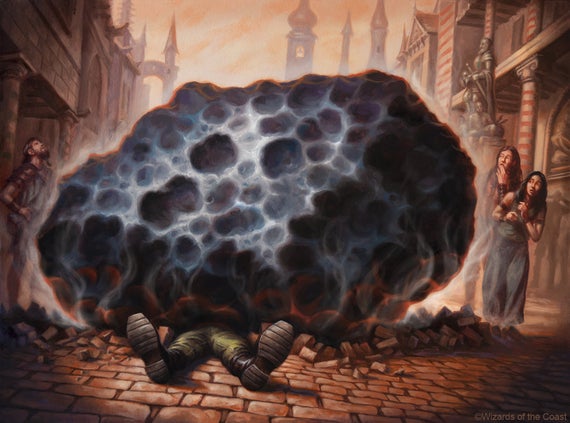
(Meteorite | Art by Scott Murphy)
Running the Mill Mana
Welcome to Too-Specific Top 10, where if there isn’t a category to rank our pet card at the top of, we’ll just make one up! (Did you know that Khalni Gem is the only mana rock that can also get you lands in your hand?)
With the recent printings of Empowered Autogenerator and Nyx Lotus, there's been much hemming and hawing about whether or not expensive mana rocks are worth it. After all, we've all heard various deckbuilders throw out mantras of how much ramp we should have in each of our Commander decks, and they're not wrong! Ramp is an inherent necessity of the format for all but the jankiest of decks. So why the turning up of the nose at our new four-mana friends?
Over the years, the format has only gotten faster as more and more folks gobble up Signets and Rampant Growths in an effort to get average mana costs down and deck speeds up. Granted, these two-mana options make less mana, but they do it in a much quicker fashion. And while Explosive Vegetation may have cut it back in the day, with everyone moving towards these faster rocks it often feels like you should be contributing to the board state by turn four, as your friend Spike is happy to remind you when they're swinging at you for fourteen because you're the only one without blockers.
Well, bah on all that, I say! Faster isn't better, it's just more powerful! If I want to play Izzet Locket to ramp me early and draw cards late, then that's my business!
So with the reckless spirit of making our decks worse rather than making them better, let's look this week at Mana Rocks that wreck our curves, but we want to be greedy and play them anyway. I'm not talking about my earlier example of Izzet Locket, either. I'm talking about the real big mana rocks:
Mana Rocks with CMC Five or More
Okay, so there aren't enough of those for an actual Top Ten. Well then, I'm talking about slightly-bigger-than-Lockets kind of mana rocks!
But maybe first we should be asking what exactly a mana rock is?
Top 10 Mana Rocks With CMC Greater Than Three
For those not familiar with the term, a mana rock is slang for an artifact that makes you mana. That's much too loose a description for us here at Too-Specific Top 10, however, so we're going to have to push a bit into the nitty gritty about what we think is and isn't a mana rock.
Here are some fine edge cases, which is really where the rubber meets the road when it comes to setting criteria. Thran Turbine actually doesn't meet our converted mana cost criteria, being a lean-yet-mean one-mana artifact. It does, however, provide Sol Ring amounts of mana for you every upkeep, albeit with the restriction that you can't spend it on spells and with the knowledge that, without an effect like Kruphix, God of Horizons or Upwelling, you'll never get to see that mana during your main phase. That's a lot of restrictions, but are any of them really the reason that Thran Turbine doesn't feel like a mana rock?
For me, it wasn't until I reached our second example that I realized what the issue was. Blinkmoth Urn does meet our mana cost criteria, and is a fine card that greedy artifact decks the world over play despite it often not coming out until turn five. It also provides you with mana, which is certainly a prerequisite when it comes to discussing mana rocks. What both it and Thran Turbine lack, however, is a tap symbol.
How artifacts are utilized has changed a lot over the years, but if you notice the initial Alpha printing of Sol Ring above, it doesn't actually have a tap symbol on it. In the initial printings of Magic, it was known knowledge from the rule book that any artifact that was "used" would be tapped, which means that the initial printings of cards like Sol Ring, Icy Manipulator, and Nevinyrral's Disk didn't actually have tap symbols on them, but were nonetheless expected to be tapped. This caused confusion, as other artifacts with triggered or had universal effects, such as Howling Mine and Winter Orb, and did not tap of their own accord (although you could tap them to end their effects until they untapped).
I believe this age-old problem from the dawn of Magic is the reason that Blinkmoth Urn and Thran Turbine don't feel like mana rocks. With them both being triggered abilities that don't require a one-time use tap effect, they just don't fit the typical mindset of most mana rocks that we've seen over the years. In short, they don't tap when you "use" them, and as such, don't feel like a magical piece of jewelry you can draw mana from. The same is true of our third example, Primal Amulet, a universal cost reduction effect akin to Sapphire Medallion. While it is a magical piece of jewelry that affects your mana, you aren't using it to draw mana from. Or are you? Primal Amulet does tap for mana once it's transformed, as does every one of the Ixalan flip lands.
But that's just it, they're flip cards. They transform from one type of permanent to another, ceasing to be artifacts and therefore ceasing to be mana rocks. While I don't think many would dispute that Treasure Map can ramp you both with Treasures and by providing you with a land that you did not have before, I also don't think many would consider it a ramp spell primarily, nor include it with their mana rocks while sorting. Primal Amulet is more likely of being included in the "Mana Ramp" pile while you're putting together a deck or tweaking it. In my mind, however, that simply confirms that it is a corner case, rather than being brought up to full mana rock status. That slight pause you feel when attempting to sort it between your ramp pile and your copy effects pile in your Spellslinger deck makes all the difference.
Finally, while mana dorks like Palladium Myr and Hedron Crawler are artifacts that tap for mana, creatures in my mind fall clearly under the "mana dork" label as opposed to the "mana rock" label. After all, you wouldn't want your Signet necklace growing legs and walking away, would you?
So, tap symbols are necessary for that true mana rock feel, as is the rock being a rock rather than a Rock Hydra. This brings us to our final criteria for our expensive mana rocks:
Criteria: Noncreature artifacts that tap to add mana to your mana pool while they are artifacts, fit within the colorless commander identity, and have a converted mana cost of four or greater. As is tradition, all results are ordered by EDHREC Score.
 10. Coveted Jewel
10. Coveted Jewel
I said in the intro that the underlying need to play these expensive mana rocks was greed on the part of the deckbuilder. Well, look no further than Coveted Jewel for the greediest of those players. Ramping by three turns and drawing three cards is about as good an effect as you can get stapled onto a single rock, only it may not end up being your rock by the time it's all said and done!
Not everyone sporting this ginormous gem is looking to play fair with their greed, however. For instance, if you can sacrifice Coveted Jewel in response to someone else trying to get a hold of it, then there's really not as much risk involved as there usually would be. Then there's always Zedruu the Greathearted decks, which are more than happy for you to own a few of their nice things... Although there's usually a caveat.
9. Empowered Autogenerator
Our new addition to this list from Commander 2019 is perhaps the slowest mana rock ever printed. Even the Mana Batteries could tap for mana on the first turn they came out, after all!
In fact, I believe that Empowered Autogenerator was actually a shout-out to these old Legends mana rocks, or at least an attempt to update them so that they might be useful in a particular niche. It turns out that there is, indeed, a niche for this updated power provider in the varied and multiple decks that care about counters of one sort or another. The real question is if you can manage to get three or four charge counters onto a card in a turn, why wait a turn to start? Green Mana Battery might not be able to make different colors of mana, but it can put a counter on itself the turn it comes into play! Oh right, because those go away instead of stacking up, and we're being greedy here.
8. Prismatic Geoscope
If you do find yourself needing a few different types of mana at once, however, then you could do worse than looking the way of Prismatic Geoscope. With Dual Lands being able to supply two different land types at once, you can effectively skirt the original intent of the Domain mechanic and achieve all five basic land types with only three lands. This makes a Prismatic Geoscope on turn five effectively double the amount of mana available to a five-color Commander deck. This is also known as "two Jodah's a turn" in the business.
7. Sisay's Ring
Sisay's Ring gets you an extra two mana for four mana without having to come into play tapped like Worn Powerstone.
There, now that that's out of the way, can we talk about the huge flavor change we had here between the Visions and Seventh Edition versions of this card? Not only is the original artwork by Donato Giancola just really cool, it said a lot about Sisay, Weatherlight Captain's leadership abilities. "With this ring, you have friends in worlds you've never heard of," is a really cool line, and it really expressed just how awesome Sisay was, flying around all day in the Weatherlight banding people together under a common goal. Not only that, but it made the ring into a symbol of being able to draw resources and tactics from allies around you, a really cool concept for a mana rock.
Or it's a pretty magic ring. That works, too, I guess.
6. Ur-Golem's Eye
For those of you wondering why the Mirrodin version of the four-mana-mana-rock-that-makes-two-mana is more prevalent than the Visions version, it's because it's both cheaper and was printed in a Commander set. That said, it's only ten cents cheaper, and I know that I, for one, wouldn't mind having more interesting artwork with an old-school border if I was looking around for another four-mana-mana-rock-that-makes-two-mana for one of my Commander decks.
Look, I think we can pump up those Visions Sisay's Ring numbers is all I'm saying.
5. Firemind Vessel
Sisay's Ring, Ur-Golem's Eye, and Hope of Ghirapur aside, some decks like to play colors. Sometimes even in multiples. Perhaps that explains why Firemind Vessel has snagged away the number five spot ahead of the colorless options that are a bit faster. After all, having all of the colors of mana you need to play is a small price for having to wait a turn to be able to use them when it comes to mana screw. It should also be noted that careful reading is necessary for this card, as it does say "two mana of different colors", which is very different than the normal "two mana of any color". This can be a boon in many decks, as it can provide you with access to two colors you may not have had access to before. It does make playing triple mana things like Necropotence and Cryptic Command a bit of a no-go, however.
4. Dreamstone Hedron
As we already saw with Coveted Jewel, paying six mana for three turns worth of ramp and three cards is a pretty decent deal. Dreamstone Hedron, however, is a little less greedy about it than Coveted Jewel, having no downside and only allowing you to draw the cards once you've paid three mana and sacrificed it. Still, as a huge fan of the aforementioned Locket cycle, I do have to admit that the ability to not only replace a rock in the late game but actually get card advantage out of it is invaluable. Strangely, however, I find that the increased reward off of the Jewel in the decks where the risk either plays into the deck's strategy or is at least minimized by it seems more valuable. Dreamstone Hedron is fine, don't get me wrong, but it's so safe that there's really not any pizzazz to it, which really makes me wonder if it should be seeing as much play as it is.
3. Hedron Archive
Speaking of Lockets and card advantage, Hedron Archive! Strictly better than both Ur-Golem's Eye and Sisay's Ring, Hedron Archive allows you to draw two cards off of it in the late game for a mere two mana.
Compare this to the other options at lesser mana amounts, and it does seem like Hedron Archive's niche is well deserved. Mind Stone is much more popular at 52,005 decks as opposed to 25,812, and there's good reason for that. But back to the theme of expensive mana rocks, Hedron Archive not only gives you more mana at the increased price, but also generates actual card advantage in the late game, as opposed to just replacing itself like Mind Stone does. Granted, 63% of decks which are playing the Archive are playing the Stone as well, but if you did have to choose there is a clear delineation line to do so. The same goes for the Cluestone versus the Locket debate, only comparing them both to Hedron Archive, the question comes down to whether or not you need more raw colorless ramp or more mana fixing.
2. Thran Dynamo
Speaking of strictly better than Sisay's Ring and Ur-Golem's Eye, Thran Dynamo. Unfortunately, you are going to pay for that extra mana outside of play, as Thran Dynamo costs ten times the inferior four-mana rocks at almost five dollars. Still, this hasn't dissuaded many, as the Dynamo comes in at number two on the list, seeing play in eleven percent of all Commander decks at 31,116 inclusions. This actually astounded me. I know I see this card in play every once in a while, but I never would have guessed that it was in one of every ten decklists out there.
1 . Gilded Lotus
Gilded Lotus, on the other hand, wasn't much of a surprise at all. Even before being reprinted in Dominaria, this card has been a staple of decks across the board. While looking at the EDHREC page might give you the idea that it's more a Stax staple than anything else, the reality is quite the contrary. Gilded Lotus is that card that can fit into any deck in the format, especially at the Battlecruiser power level. It's the card you see in that new player's trade binder they're asking you to peruse through for stuff they can make a Commander deck with that you pull immediately. While it may fall to the wayside as decks get more tuned with more speed, it's always going to be there as a standby for any deck trying to meet that initial "ten slots of ramp" bar, and that's why it will always have a place in Elder Dragon Highlander.
Honorable Mentions
The astute among you may have noticed that I snuck the extra stipulation of "colorless commander identity" into the criteria without really going into detail as to why. While I do feel that things like Charcoal Diamond and the like count as mana rocks, I didn't feel quite the same about some of the larger mana versions that would have been in the top ten, most notably The Great Henge.
While this did also cut out some good examples of mana rocks in the form of the mana batteries and Visage of Bolas, they wouldn't have been anywhere close to the top ten, anyway. The real loss to my feeling that The Great Henge shouldn't count as your prototypical mana rock was Pyromancer's Goggles. Goggles would have come in at sixth on the list, right behind The Great Henge.
As for the continuation of our main list, the quality falls down quite quickly after Coveted Jewel, and there really aren't that many expensive mana rocks in general. In fact, there are only seven more if you don't count the mana battery cycle:
11. Tome of the Guildpact
12. Nyx Lotus
13. Khalni Gem
14. Paradise Plume
15. Meteorite
16. Charmed Pendant
17. Ice Cauldron
I fully expect Nyx Lotus to climb the ranks as Theros Beyond Death gets more widespread among decklists, and I would have also guessed that Tome of the Guildpact would have been knocking on the door of the top ten if for no other reason than Niv-Mizzet Reborn decks. That said, I am a little shocked and saddened to see Charmed Pendant so far down the list. With the prevalence of Devotion around Commander and the varied and many versions of library manipulation decks (think Aminatou, the Fateshifter, Yennett, Cryptic Sovereign, and my personal favorite, Sapling of Colfenor), I would have expected a few more decks to be combining the two in some fashion. Seems like something that the lower-powered K'rrik, Son of Yawgmoth decks might want to look into, at the very least.
What Do You Think?
This top ten and article at large has featured many a slower option with a lot of potential upside, yet most of the complete list of 17 cards above see very little to almost no play. I'm interested as to the reasons why, and if it is simply that the format is getting faster.
And finally, what do you think of expensive mana rocks? Do they still have a place in Commander despite the quickening pace we're seeing all around? Do you feel like that quickening trend is a good thing, or do you miss the days of true Battlecruiser Magic?
Let us know in the comments, and we'll see you at the local house table that banned Sol Ring.
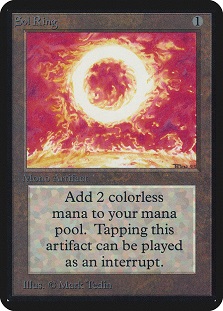
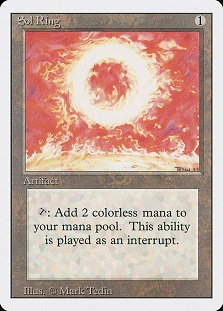
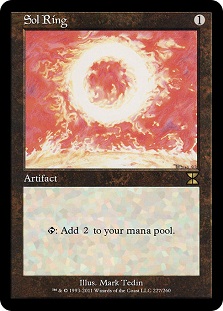


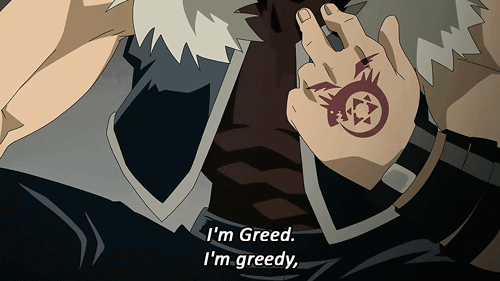

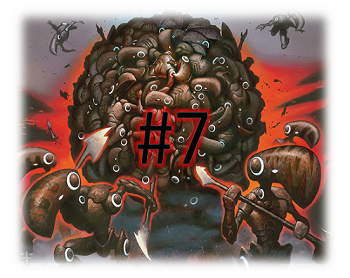
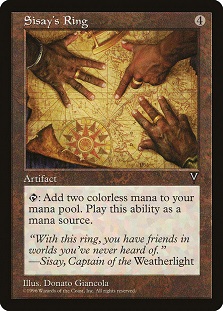
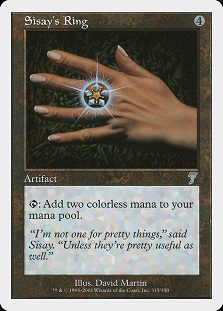
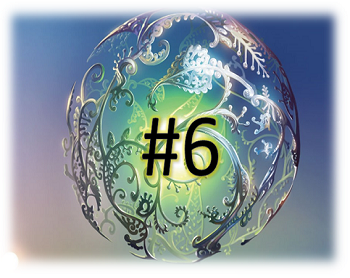



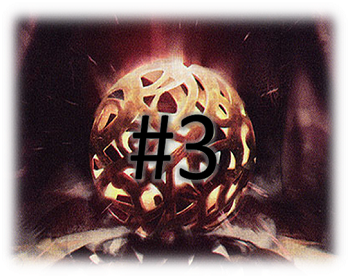
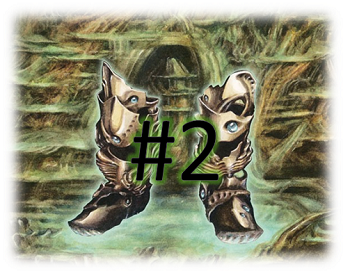

EDHREC Code of Conduct